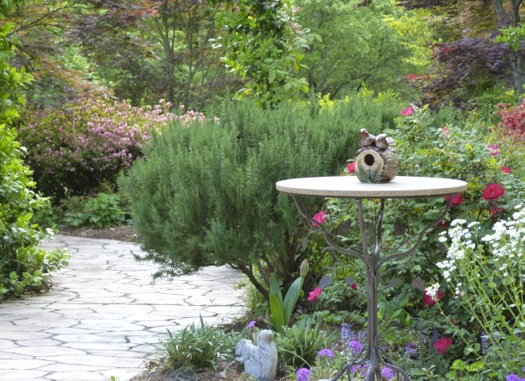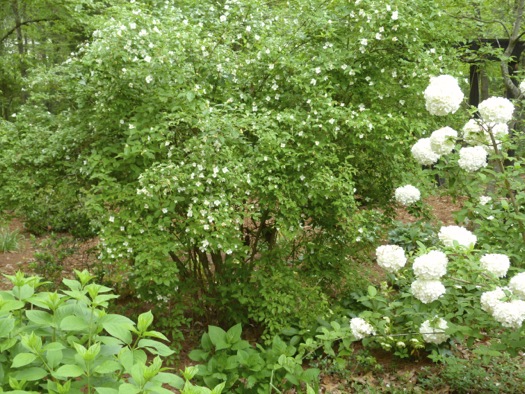My Voodoo Lily is Blooming!
 Saturday, March 7, 2015 at 8:15PM
Saturday, March 7, 2015 at 8:15PM 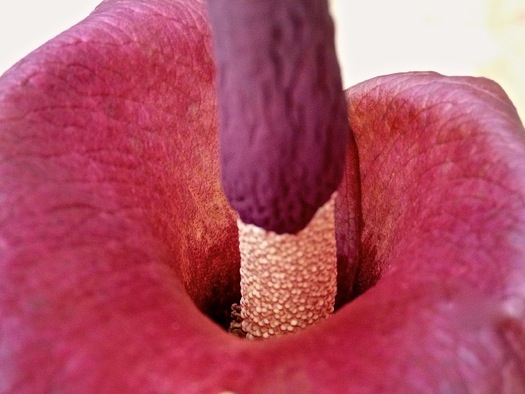 One day toward the end of January I innocently opened my pantry door, and a coiled snake was staring me in the face.
One day toward the end of January I innocently opened my pantry door, and a coiled snake was staring me in the face.
My startled gasp had barely escaped my lips and my heart had not recovered its normal rhythm, when I realized it was not a snake at all. It was my Amorphophallus konjac, AKA voodoo plant, snake lily, devil's tongue and corpse plant. All of these names are appropriate.
This is what happened: Back in the fall I had dug up the tubers of my two voodoo lilies, which live in pots out in the garden through spring and summer. After brushing the dirt off the tubers, I put them in a sack and placed them on a shelf in my pantry, with plans to replant them when new growth began in the spring.
My excuse for owning these plants is that I did not know what I was doing when I bought them; and once I had them, it was too late. For the full story, read my old post Under the Spell of the Voodoo Plant. When I first acquired them in 2010, my voodoo plant tubers were tiny, the largest being only about the size of an almond. It takes about five years for these plants to grow to blooming size. The largest one was almost four inches across when I dug it last fall, and 2015 would be its fifth year; so I was expecting it to bloom this spring.
 This is what the larger voodoo plant looked like after I rescued it from the pantry shelf. The tuber is almost four inches across. Note how wide the stalk is as it emerges.I thought the smaller one, which was about an inch smaller, could need another year.
This is what the larger voodoo plant looked like after I rescued it from the pantry shelf. The tuber is almost four inches across. Note how wide the stalk is as it emerges.I thought the smaller one, which was about an inch smaller, could need another year.
Notice I said I thought it would bloom this spring. The reason the plant is called corpse plant is because the flower is said to smell exactly like rotting flesh. (Surely that was an exaggeration!) Because it would be out in the garden when it bloomed, I was not concerned.
The plant decided to surprise me. The smaller tuber sent up a slender stalk, which poked a hole through the plastic sack and then grew upward until it encountered the bottom of the shelf above it. It then turned sideways and reached the cabinet door, which I am sure it would have pushed open if I had not first opened it myself.
I stared in amazement at this thing. There was a swelling at the end of the coiled, spotted stalk, which could easily be interpreted as the head of a snake. I realized the plant was going to bloom.
In February. Inside my house. Oh, no.
Upon research, I discovered that Amorphophallus konjac sends up its bloom in late winter to early spring. So my plants were right on time. I untangled the tuber from the plastic sack. The larger tuber was also pushing up a stalk. It was shorter but much thicker than the other one. It was going to bloom, too.
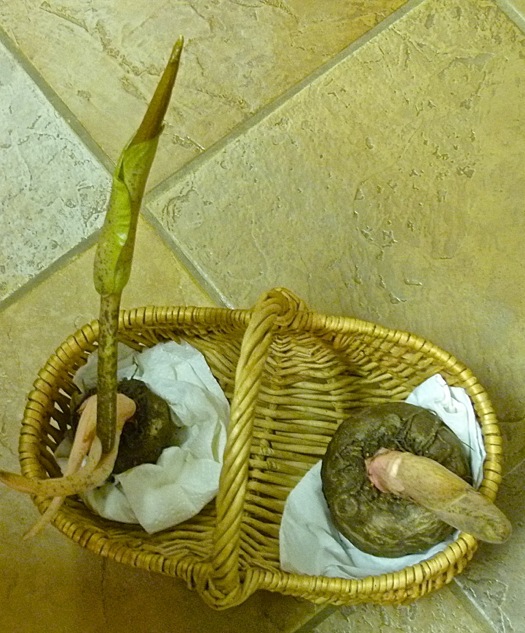 This photo was taken February 1, about a week after I took the voodoo plants out of the pantry. The smaller tuber is still leaning dramatically to one side, but it has begun to straighten.
This photo was taken February 1, about a week after I took the voodoo plants out of the pantry. The smaller tuber is still leaning dramatically to one side, but it has begun to straighten.
I transferred the tubers to a pot, and I watched anxiously as both plants grew rapidly. With space and light, the little one soon straightened itself. Its inflorescence unfurled by the second week of February.
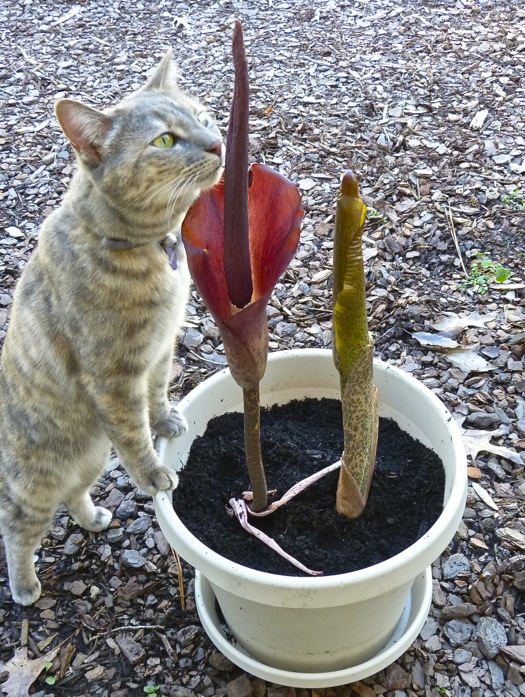 February 7. The first bloom! Our cat Autumn checks out the smell.Powerful enough to bring tears to my eyes, the bloom had the stench of a very bad crime scene. Fortunately, we had a few warm days while it was blooming, so I was able to sit it outside during the day. We were amazed by how many tiny flies came to the plant, hunting for food but being cruelly tricked even as they did their part in pollination. At night I brought the plant inside and put it in the back part of the house where our cat Autumn stays. I made sure the door was firmly shut between that area and the main part of the house. I am not sure how Autumn felt about this arrangement. After one whiff, she kept away from the plant.
February 7. The first bloom! Our cat Autumn checks out the smell.Powerful enough to bring tears to my eyes, the bloom had the stench of a very bad crime scene. Fortunately, we had a few warm days while it was blooming, so I was able to sit it outside during the day. We were amazed by how many tiny flies came to the plant, hunting for food but being cruelly tricked even as they did their part in pollination. At night I brought the plant inside and put it in the back part of the house where our cat Autumn stays. I made sure the door was firmly shut between that area and the main part of the house. I am not sure how Autumn felt about this arrangement. After one whiff, she kept away from the plant.
The stink persisted about a week, and then after a couple of weeks the bloom began to decline. Meanwhile, the larger plant was growing to about three feet tall with a stalk over an inch thick. Now, a month after the small one bloomed, the larger one has opened its cobra-like hood.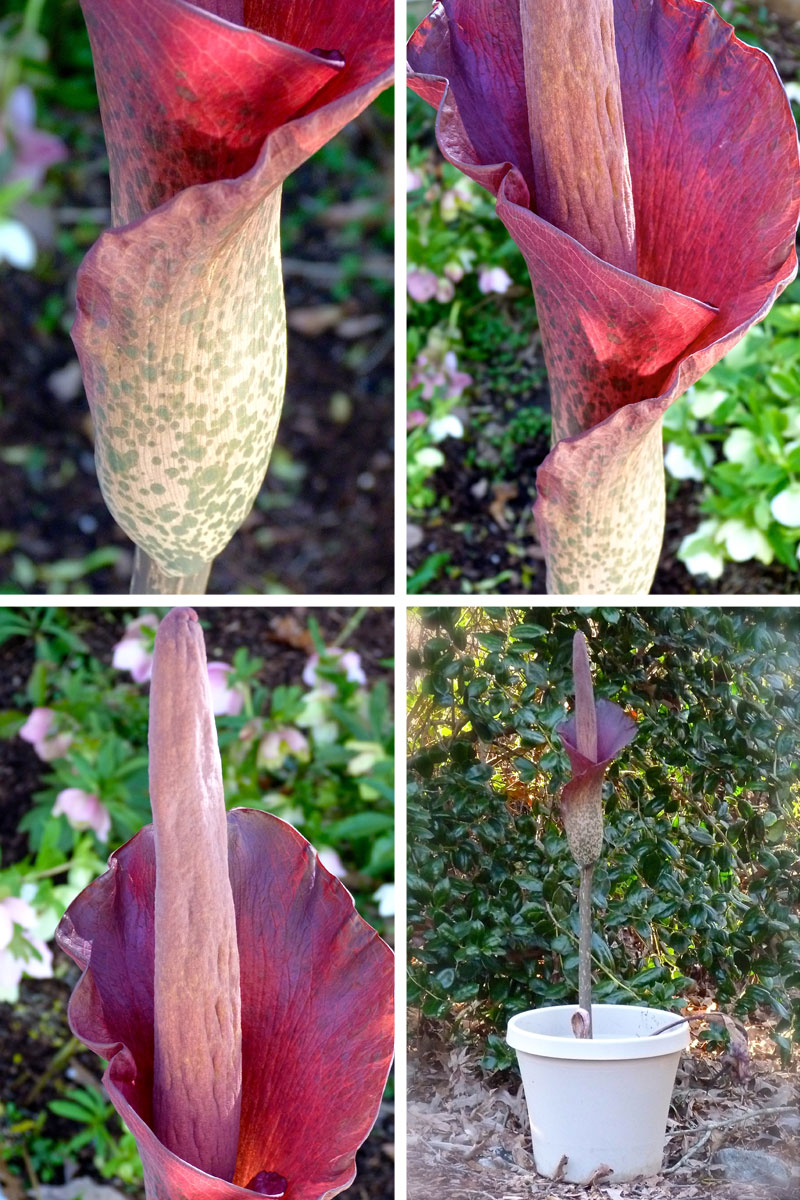 Strange and beautiful! In the lower right image, one can see remnants of the first bloom, to the right of the stalk.
Strange and beautiful! In the lower right image, one can see remnants of the first bloom, to the right of the stalk.
The weather, which has been freezing this week, warmed up today and will stay mild. Outside the voodoo plant goes! By the time it has finished blooming, it will be time to plant these weird plants in their summer pots. In a month or so they will send up unusual, umbrella-like leaves, which will add an exotic note to the garden.
My plants are young. In coming years the tubers could grow to a foot in diameter and send up stalks nearly six feet tall. Amorphophallus konjac is stunning in every way. What do you think? Would you forgive the stench?
 Amorphophallus konjac,
Amorphophallus konjac,  exotic flowers,
exotic flowers,  voodoo plant in
voodoo plant in  plants
plants 

